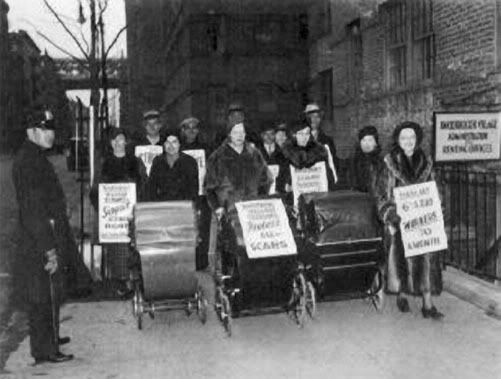
The Knickerbocker Village rent strike (from an article on nyc tenant history) , employing appeals to public officials and the media more than courtroom advocacy, provided an equally innovative model of tenant organization. The setting of this conflict was a sixteen-hundred-unit complex located in a deteriorated neighborhood just north of the Brooklyn Bridge (Manhattan side), which had been financed with a loan from the Reconstruction Finance Corporation that limited its developers to a 6 percent profit and rents of no more than $12.50 per room. Designed as a model project for middle-class New Yorkers, Knickerbocker Village attracted a tenant population of young, college-educated professionals -- professors, architects, social workers, teachers, lawyers, civil servants, and businessmen. Arriving on moving day with high expectations, they found the buildings unfinished and the management poorly prepared for their arrival. Elevators did not work; apartments lacked finished floors, bathroom and kitchen fixtures, and painted walls; "model" features of the development -- laundry rooms, radio hookups, children's playrooms -- proved inoperable or poorly equipped. Worse yet, management representatives, failing to take tenant complaints seriously, offered insolent responses or avoided contact altogether.
Knickerbocker Village residents, who had developed an instant camaraderie during the move-in fiasco (and who were not accustomed to this treatment in their professional lives), swiftly mobilized to ease their predicament. Less than three weeks after moving day (October 1, 1934), over six hundred Villagers came to a meeting at a local public school and voted to withhold their next month's rent unless management agreed to a long list of demands, including repairs of apartments, elevators, and public areas, and reimbursement of tenants for moving expenses. The strategy tenants pursued demonstrated a shrewd understanding of politics, public relations, and the weight conferred by their own professional status (the strike committee had forty-four lawyers and seventeen journalists among its supporters). Within one week, the strike committee had set up meetings with the mayor, the State Housing Board, and the Village management (the Fred M. French Company), and had managed to secure four full-length articles in the New York Times. In addition, the strikers formed a legal defense committee, a newsletter, and a social activities committee to help firm up their support with the rest of the tenants. By mid-November the Knickerbocker Village management, reeling under the force of this organizational blitzkrieg, agreed to negotiate; a compromise was reached that resulted in repairs of unfinished apartments and nearly $25,000 in reimbursements to aggrieved tenants.
The successful strike generated tremendous esprit de corps among politically active tenants. One week after the French Company settled tenant claims, strike leaders announced that they were forming a permanent Knickerbocker Village Tenants Association to undertake a program of cultural and educational activities within the housing complex. The tenant leaders, ranging politically from New Dealers to Communists, approached the association as an opportunity to create a social and cultural environment that reflected the "activist" currents of the time, but they ran up against the grim opposition of the French Company, which saw the association as a threat to its control of the project. The company refused to grant meeting space to the association, set up a rival tenant group, funded an anti-association newsletter, and finally, in the summer of 1935, informed seventeen association leaders that their leases would not be renewed because of their "evident unhappiness" with conditions in the project.
The effort to evict association leaders, even more than the strike, radicalized many residents of the project. Although the association lost an eleven-month court battle to force renewal of the leases, it used the issue of arbitrary management tactics to expand its following among the tenants and create strong ties with public officials, journalists, and civic organizations concerned with housing reform. To the French Company's dismay, a whole new group of association leaders emerged who expanded its cultural and political activities, kept its newsletter alive, and expanded association membership to over a thousand tenants, thus swamping its management-sponsored rival. "Knickerbocker Village became a beehive of activity," one tenants leader recalled, "one of the most interesting places in New York to live in." For the new tenant leadership, the recalcitrance of the French Company became a metaphor for the problems all tenants faced in winning recognition of their rights to free association and collective bargaining, and they became evangelists for tenant activism in their Lower East Side neighborhood and the city as a whole.
The Knickerbocker Village leaders possessed some unique assets in their efforts to serve as the catalysts for a citywide tenant movement. First, they possessed professional skills, and they projected a cosmopolitan style that no militant tenant activists had previously commanded. College educated and "Americanized" (no foreign accents here, even among the "ethnics"), they combined a romantic faith in mass action with a hardheaded knowledge of the law, public relations, and the legislative process. Second, their radicalism, although sincere, lacked the rough edges displayed by immigrant Socialists and Communists. Recent converts to the Left, they affected a nonpartisan aura that never compromised their professional expertise or jeopardized smooth social relations with liberals. Third, they had the backing of a strong, stable tenant association that provided both a model and a source of financial and political support for their activities. At a time when housing reform had become a major issue in city politics, Knickerbocker Village activities were uniquely situated to bring together a grass roots tenant movement that sought links with liberal reformers in the settlement houses and the city government.






No comments:
Post a Comment